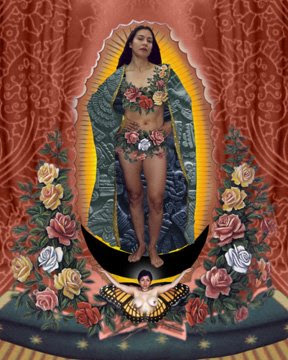This a brilliant collection celebrating the love of and devotion to the enduring influence of the Virgin of Guadalupe. Castillo includes male and female writers, agnostics, traditional Catholics, feminists, and Santeras in this eclectic homage. This anthology contains essays, memoir, poetry and rhetoric celebrating a complicated relationship with a folk deity, one that is much less European, and traditionally Catholic, much more than that. This is a deity that is full-bodied, sensual, actively involved in the thrum and unraveling and reclamation of the world. In the preface, Castillo writes that this brown-skinned Mary appeared in 1531; but in reality, existed as Tonatzin, a thousand years before the conquest. The thread that weaves these essays together is the fascination with the ways in which Tonatzin, the moon goddess, morphed into this particular image of Mary.
She is essentially Latina, essentially an emblem of indestructible indigena roots, which survived through a syncretic practice. (Much like the ways Mejicanos/Chicanos themselves survived the conquest.) Authors such as Elena Poniatowska, Luis J. Rodriguez, Sandra Cisneros, Denise Chavez, and Gloria Anzaldua write with clarity, precision and grace, depicting a 'Virgin' that has survived the conquest and embodies a multiplicity of identities, based on the multitude of goddesses that are her antecedents. Shaped in their image, this goddess is rooted in the indestructible, the indigenous. Each of imbue this goddess with qualities the colonizers could not imagine, let alone control.
This Virgin is an amalgam of mother, consort, liberator, guardian of the living and the dead, and wellspring of the revolutionary. Of particular interest to me was Sandra Cisneros' essay entitled, Guadalupe the Sex Goddess. In it, she traces the Virgin's pre-Columbian roots as icon of fertility and sexuality, central to a cosmology in which female sexuality was valued, not denigrated. In that cosmology, Guadalupe's antecedents included Tonatzin, the moon Goddess who embodies the feminine principle of cyclical re-creation. She (Guadalupe) is also linked to Tlazolteotl, patron of sexual pleasure and Tzinteotl, goddess of the rump. Lastly, there is a connection Tlaelcuani, the filth-eater, she who transforms the ugly, the corrupted, into the sanctified and renewed. Cisneros on her significance:
When I look at the Virgin of Guadalupe now, she is not the Lupe of my childhood, no longer the one in my grandparent's house in Tepeyac, nor is she the one of the Roman Catholic Church...Like every woman who matters to me, I have had to search for her in the rubble of history. And I have found her. She is Guadalupe the sex goddess, one that makes me feel good about my sexual power, my sexual energy, who reminds me I must...speak the most basic, honest truth...write from my panocha.
This is the vivid imagery, the hidden history I need in order to shape a reconstruction of identity, one woven with both Catholic and more ancient threads. The is the Goddess that saves and transforms sexual violence and abuse, celebrates the sacred, sexual body. A formidable read. This book has helped me think about what in means to be a Latina, in a personal and epic sense.
Noticias:
Check out what's happening around pop culture, racial stereotyping, social commentary, and William Nericcio here.
Lisa Alvarado



1 comment:
Yes, Goddess of the Americas is one great read. . . .I'll hafta dust it off and give another whirl, now that I've read your blog. . .
Post a Comment